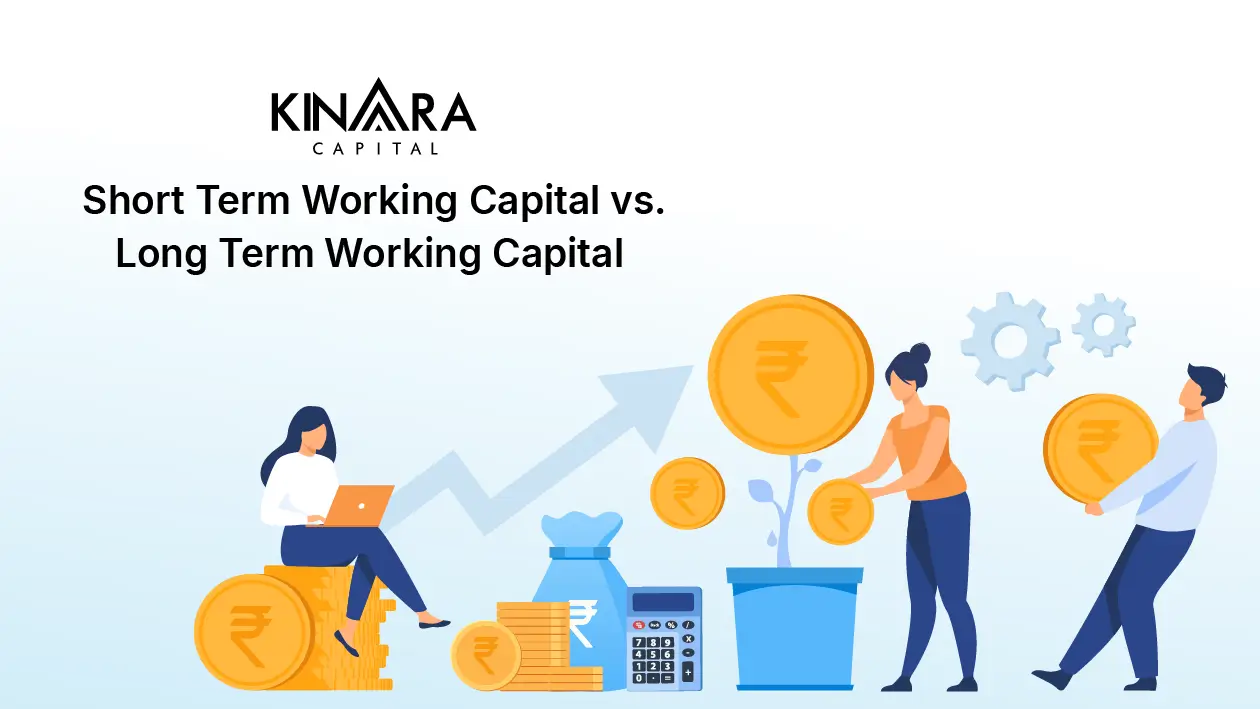
Working capital is an essential element for businesses to take off and run successfully. It refers to the capital that is used to cover day-to-day expenses, as well as tide over unexpected circumstances and finance growth plans. There are various sources of working capital, ranging from investors to personal savings of the business owner. Another significant source of working capital is working capital loans. These are especially important and useful for smaller businesses, like micro, small, and medium enterprises (MSMEs), because they typically have limited resources at their disposal. Since they operate on tighter budgets and have financial constraints, they can leverage working capital loans to their benefit whenever the need for capital arises.
There are two main types of working capital, long-term working capital and short-term working capital. Let’s explore what these two categories mean, and what financing for each looks like.
Short-term working capital is the capital required by a business to finance its day-to-day operational needs, such as buying inventory, paying employee salaries, paying suppliers and meeting other short-term obligations. The short-term capital requirement of a business can be calculated by subtracting its current liabilities from its current assets. Current assets comprise cash, accounts receivable, inventory, etc. and current liabilities include accounts payable, short-term debt, etc.
Managing short-term working capital effectively is crucial for businesses to ensure smooth operations and liquidity. Having an inadequate amount of working capital can lead to difficulties in meeting short-term obligations. To make up for this, businesses can seek working capital financing. Balancing working capital is a key aspect of financial management for businesses, ensuring they have enough liquidity to cover their short-term needs without tying up too much capital in non-productive assets, and this can be achieved by tapping short term sources of working capital.
Long-term working capital is the amount of capital needed for a business to sustain its operations over the long term. It is essential to ensure the ongoing viability and growth of the business over an extended period. It includes funds needed for growth and expansion-related activities such as acquiring equipment, improving business premises, expanding operations and product offerings, etc.
While working capital in general sustains the operations of a business, without adequate long-term working capital, a business would stagnate. All businesses require periodic funding infusions to put their growth plans into action, and this is where long-term working capital comes into play. Long-term sources of working capital can help a business with the funding it needs to fuel growth. Long-term sources of financing working capital can vary depending on the type of business and its specific requirements.
Here are the differences between short-term and long-term working capital:
Working capital can be sourced in several ways. Sources of working capital, whether it is short-term sources of working capital or long-term sources of working capital, can be the entrepreneur’s personal savings or the profit margin. It can also come from investors, although this is rare in the case of MSMEs. One reliable source of working capital for MSMEs is loans. While it might be difficult for them to access loans from traditional lenders like banks, new-age financial service providers like fintech NBFCs are opening doors for them to access formal financing with far fewer hurdles.
Working capital lenders have varying regulations and requirements. The best working capital loans for MSMEs are collateral-free ones with easy documentation and quick processing. Kinara Capital, an RBI-registered fintech NBFC, offers both long-term and short-term (only for existing Kinara customers) collateral-free working capital loans to small business owners in the manufacturing, trading and services sectors. Some of the top features of business loans from Kinara Capital include:
● Collateral-free working capital business loans from ₹1 lakh-₹30 lakhs
● 24-hours loan disbursement directly into the applicant’s bank account
● Minimum documentation and secure portal for easy uploads
● Flexible business loan offerings for working capital
● Doorstep customer service and call-center support available in vernacular
● Automatic discount for MSME women business owners with HerVikas program. No separate application required
Kinara Capital offers collateral-free working capital loans for small businesses to help them seize every growth opportunity. Registered MSME owners can evaluate their eligibility for a loan in just 1-minute by starting the digital-first application process on the Kinara Capital website or by downloading myKinara App. Eligible MSME entrepreneurs can submit the necessary documents and the loan amount will be disbursed digitally to their bank account within 24-hours.
Kinara Capital also provides multilingual doorstep customer services to MSMEs interested in learning more and needing assistance to apply. Also, we have a dedicated customer support team available between Monday – Friday (9.30 AM – 6.00 PM) at our toll-free number 1800-103-2683 for any questions or assistance. This ensures that entrepreneurs can get the help they need throughout the loan process.
FAQs
Why is working capital important for a Business?
Working capital keeps the day-to-day operations of a business running smoothly, and also finances growth plans. So it’s critical for the efficient running of a business.
How can a business improve its short-term working capital?
Businesses can effectively manage their short-term working capital through efficient inventory management, timely receivables collection, and effective payables management to optimize cash flow.
What are the four main components of working capital?
The four main components of working capital are cash, accounts payable, accounts receivable, and inventory.
What challenges do businesses face in securing long-term working capital?
Businesses, particularly MSMEs, may face hurdles in securing long-term financing because they don’t have an established credit history. Lenders may require collateral or evidence of strong financial performance to provide them with loans.
